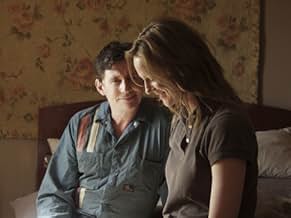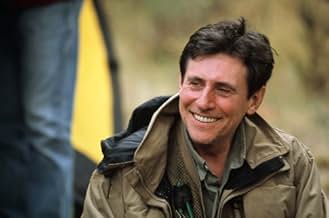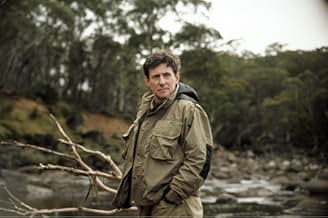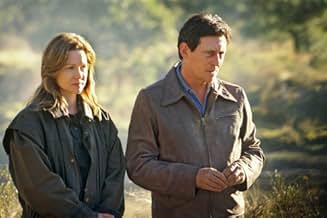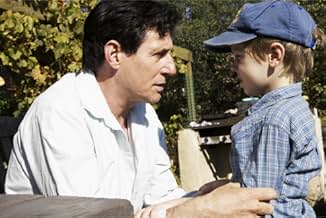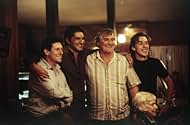CALIFICACIÓN DE IMDb
6.3/10
7.2 k
TU CALIFICACIÓN
Después de que cuatro hombres que han salido a pescar descubren un cadáver en el agua, deciden no informar sobre ello al momento para seguir pescando.Después de que cuatro hombres que han salido a pescar descubren un cadáver en el agua, deciden no informar sobre ello al momento para seguir pescando.Después de que cuatro hombres que han salido a pescar descubren un cadáver en el agua, deciden no informar sobre ello al momento para seguir pescando.
- Dirección
- Guionistas
- Elenco
- Premios
- 11 premios ganados y 22 nominaciones en total
- Dirección
- Guionistas
- Todo el elenco y el equipo
- Producción, taquilla y más en IMDbPro
Opiniones destacadas
Jindabyne is a profound art house crime/thriller/drama set entirely in an the isolated Australian town of Jindabyne, starring Laura Linney (Love Actually, The Exorcism of Emily Rose) and Gabriel Byrne (Spider).
An Irishman (Bryne), living in Australia with his American wife (Linney), is on an annual fishing trip, with four friends, when they come across the murdered body of a young Aboriginal woman (Tatea Reilly). Having looked forward to their trip for so long, the friends decide to leave the woman alone and report her to the police once their trip is over. Much to the disgrace of their wives, the community and the Aboriginal tribe.
I'm going to try and review this without giving it all away, but this is another very interesting and unusual thriller in so many ways. For a start, the majority of the film focuses on Linney and Byrne's marriage and the young girl's murder acts as a sort of subplot. Secondly, the director, Ray Lawrence (who has only directed two other films in the last 22 years), filmed all of it in natural light IE no fake lighting was used throughout.
The script by Beatrix Christian, adapted from the short novel 'So Much Water So Close to Home', on which the film is based, is also written in an unusual way. For instance,, the film is chronologically told, yet none of the scenes are linked nearly all of the scenes (at least in the first half) are random anecdotes of Linney and Bryne's family life. One criticisms I'd give the script would be that although it is obvious Bryne is Irish and Linney is American, it is not explained as to why they are in Australia. Another criticism, in general, is that although we are supposed to believe that the men are so desperate to fish they are even willing to ignore a dead woman's body this is not emphasized enough in the acting, script of direction. Because of this, I didn't sympathize with Bryne's character as much as I could have done.
Laura Linney and Ed Byrne are pretty much the only two actors who are recognizable to international audiences, out of the very large cast. Both are brilliant in their roles, particularly Linney proving once again she is one of Hollywood's more overlooked actresses.
The film is worth seeing for so many reasons: brilliant acting from the entire ensemble cast, it's intriguing direction, unusual storyline and its accurate insight into the Aboriginal religious practices.
An Irishman (Bryne), living in Australia with his American wife (Linney), is on an annual fishing trip, with four friends, when they come across the murdered body of a young Aboriginal woman (Tatea Reilly). Having looked forward to their trip for so long, the friends decide to leave the woman alone and report her to the police once their trip is over. Much to the disgrace of their wives, the community and the Aboriginal tribe.
I'm going to try and review this without giving it all away, but this is another very interesting and unusual thriller in so many ways. For a start, the majority of the film focuses on Linney and Byrne's marriage and the young girl's murder acts as a sort of subplot. Secondly, the director, Ray Lawrence (who has only directed two other films in the last 22 years), filmed all of it in natural light IE no fake lighting was used throughout.
The script by Beatrix Christian, adapted from the short novel 'So Much Water So Close to Home', on which the film is based, is also written in an unusual way. For instance,, the film is chronologically told, yet none of the scenes are linked nearly all of the scenes (at least in the first half) are random anecdotes of Linney and Bryne's family life. One criticisms I'd give the script would be that although it is obvious Bryne is Irish and Linney is American, it is not explained as to why they are in Australia. Another criticism, in general, is that although we are supposed to believe that the men are so desperate to fish they are even willing to ignore a dead woman's body this is not emphasized enough in the acting, script of direction. Because of this, I didn't sympathize with Bryne's character as much as I could have done.
Laura Linney and Ed Byrne are pretty much the only two actors who are recognizable to international audiences, out of the very large cast. Both are brilliant in their roles, particularly Linney proving once again she is one of Hollywood's more overlooked actresses.
The film is worth seeing for so many reasons: brilliant acting from the entire ensemble cast, it's intriguing direction, unusual storyline and its accurate insight into the Aboriginal religious practices.
In the Australian town of Jindabyne, the former race champion Stewart Kane (Gabriel Byrne) works in a gas station with his partners and friends Carl (John Howard), Rocco (Stelios Yiakmis) and Billy (Simon Stone). His impassionate marriage with the unstable Claire (Laura Linney) has an unresolved issue since Claire left him when their son Tom (Sean Rees-Wemyss) was born. The great passion of Stewart is fishing and he organizes a weekend fishing trip in a remote river with his three great friends. On Friday afternoon, they park the car and hike and camp in the spot; while fishing, Stewart finds the naked dead body of an aboriginal young woman floating on the cold water. Stewart ties the leg of the woman to an arbor and they spend the weekend fishing. On Sunday afternoon, they return to the parking area and report their finding to the police. When the press releases the information, their public and private lives are deeply affected and the disturbed Claire questions Stewart's attitude while trying to help and apologize with the family of the dead aborigine.
"Jindabyne" has a storyline of great potential, with a morbid and polemic study of moral aspects of human (and consequently flawed) characters. Unfortunately the screenplay is not good and looses the focus of the main storyline entwined with many parallel and unresolved plots of supporting characters. Why Caylin-Calandria has such weird and morbid behavior? (It seems that because of the death of her mother, but it is never clear). The character of the old man that killed the aborigine is not developed. Why Claire became dysfunctional with the birth of her son? Why Stewart is still married with Claire? The attitude of Claire against her husband is annoying and in Brazil we have a saying that states "with a friend (or in this case wife) like that, Stewart does not need enemies". Anyway, the locations in Australia are stunning, the cast has great acting and it is worth watching this movie. My vote is seven.
Title (Brazil): Not Available
"Jindabyne" has a storyline of great potential, with a morbid and polemic study of moral aspects of human (and consequently flawed) characters. Unfortunately the screenplay is not good and looses the focus of the main storyline entwined with many parallel and unresolved plots of supporting characters. Why Caylin-Calandria has such weird and morbid behavior? (It seems that because of the death of her mother, but it is never clear). The character of the old man that killed the aborigine is not developed. Why Claire became dysfunctional with the birth of her son? Why Stewart is still married with Claire? The attitude of Claire against her husband is annoying and in Brazil we have a saying that states "with a friend (or in this case wife) like that, Stewart does not need enemies". Anyway, the locations in Australia are stunning, the cast has great acting and it is worth watching this movie. My vote is seven.
Title (Brazil): Not Available
This is an intriguing, evocative and multilayered film superbly acted and wonderfully filmed (mostly in single takes, it seems). It is also rather slow and meandering, and problematic. The basic plot could be set almost anywhere failure of personal relationships in the context of a failure of civic duty, but Ray Lawrence has chosen to adapt Raymond Carver's short story of the fishermen who took their time over reporting finding a woman's body to a highly specific place, Jindabyne, NSW, and to include the vexed question of black/white relationships in Australia.
As is pointed out in one of those awful cheery 1960s documentary being shown to the kids in the local primary school, the present day Jindabyne is a "second chance" sort of place, the old town having disappeared under the waters of Lake Jindabyne during the creation of the Snowy Mountains Hydro Scheme, though at very low water levels the old church steeple is said to poke out of the water. Unfortunately, as we are shown in the opening sequence there is still evil in the new town in the shape of the local electrician (Chris Heywood, very nasty), who likes to hunt and kill young women. It is his victim's body the four fishing buddies, Stewart, Carl, Rocco and Billy, find in the stream, tie to a log, fish for a day, and then the next morning decide to raise the alarm.
When it becomes public that the four delayed reporting their find to go fishing (why didn't they lie about when they found the body?) there is a predictable uproar. The dead woman was aboriginal and the local aboriginals are particularly upset since they see this as symptomatic of whitey attitudes). Rocco's aboriginal girlfriend is not impressed. But the greatest emotional impact falls on Stewart (an Irishman) and his American wife Claire whose relationship is already rocky.
At one point I thought Claire was going to crack the case, but instead we get a literally hazy scene where some kind of reconciliation between black and white is attempted. After seeing the superb "Ten Canoes" recently I found the whole aboriginal storyline contrived. What I did think was very powerful and affecting was the portrayal of a damaged marriage. Gabriel Byrne does not put a foot wrong as Stewart, an ordinary bloke resigned to what little emotional comfort he can get from his family, and Laura Linney gives great depth to her role as his wife Claire, a woman for whom motherhood is a daunting task.
The rest of the cast are fine. Debra-Lee Furness as Carl's wife Jude makes a dislikeable character understandable, John Howard as Carl puts in a solid performance and there are two good performances from child actors Eva Lazzaro as Jude's disturbed granddaughter, and Sean Rees-Wemyss as Stewart and Claire's son Tom.
Ray Lawrence clearly did not set out to create a crime story but he certainly shows that crime can have some unexpected collateral damage. He also has contributed to the "Cinema of Unease", a phrase Sam Neill once used to describe New Zealand cinema, by setting a story about personal and public guilt in such a glorious setting.
As is pointed out in one of those awful cheery 1960s documentary being shown to the kids in the local primary school, the present day Jindabyne is a "second chance" sort of place, the old town having disappeared under the waters of Lake Jindabyne during the creation of the Snowy Mountains Hydro Scheme, though at very low water levels the old church steeple is said to poke out of the water. Unfortunately, as we are shown in the opening sequence there is still evil in the new town in the shape of the local electrician (Chris Heywood, very nasty), who likes to hunt and kill young women. It is his victim's body the four fishing buddies, Stewart, Carl, Rocco and Billy, find in the stream, tie to a log, fish for a day, and then the next morning decide to raise the alarm.
When it becomes public that the four delayed reporting their find to go fishing (why didn't they lie about when they found the body?) there is a predictable uproar. The dead woman was aboriginal and the local aboriginals are particularly upset since they see this as symptomatic of whitey attitudes). Rocco's aboriginal girlfriend is not impressed. But the greatest emotional impact falls on Stewart (an Irishman) and his American wife Claire whose relationship is already rocky.
At one point I thought Claire was going to crack the case, but instead we get a literally hazy scene where some kind of reconciliation between black and white is attempted. After seeing the superb "Ten Canoes" recently I found the whole aboriginal storyline contrived. What I did think was very powerful and affecting was the portrayal of a damaged marriage. Gabriel Byrne does not put a foot wrong as Stewart, an ordinary bloke resigned to what little emotional comfort he can get from his family, and Laura Linney gives great depth to her role as his wife Claire, a woman for whom motherhood is a daunting task.
The rest of the cast are fine. Debra-Lee Furness as Carl's wife Jude makes a dislikeable character understandable, John Howard as Carl puts in a solid performance and there are two good performances from child actors Eva Lazzaro as Jude's disturbed granddaughter, and Sean Rees-Wemyss as Stewart and Claire's son Tom.
Ray Lawrence clearly did not set out to create a crime story but he certainly shows that crime can have some unexpected collateral damage. He also has contributed to the "Cinema of Unease", a phrase Sam Neill once used to describe New Zealand cinema, by setting a story about personal and public guilt in such a glorious setting.
This is a 'typical' Ray Lawrence film. Similar in its dark view of the world, to his earlier 'Lantana'. The same slow, deliberate, menacing pace, drawing out evil in every corner ("shades of David Lynch's Twin Peaks" here). Our good ol' boy Aussies (one a transplanted Irish), on a weekend trout fishing trip away from their wives, 'park' the corpse of a murdered woman they discover floating in their stream. They continue with their fishing, not reporting the find until leaving the site - for which they are intensively and unremittingly attacked by all and sundry on their return. The fact that the dead woman is an Australian Aboriginal person adds to the 'political' impact of their offense. Through all this, the real serial killer (who we see from the first scene) hovers menacingly nearby.
An interesting, if somewhat cynical, view of the highly charged inter-racial atmosphere in the Australian community: white guilt and 'political correctness'. Who are the real villains here? Our 'politically incorrect' (and morally vacuous) protagonists? Or the murderer? Accoring to Lawrence, the former, apparently.
Taught and tense throughout, the film lacks a real resolution, opting instead for a rather 'weak' ending through the redemption of the fishers.
An interesting, if somewhat cynical, view of the highly charged inter-racial atmosphere in the Australian community: white guilt and 'political correctness'. Who are the real villains here? Our 'politically incorrect' (and morally vacuous) protagonists? Or the murderer? Accoring to Lawrence, the former, apparently.
Taught and tense throughout, the film lacks a real resolution, opting instead for a rather 'weak' ending through the redemption of the fishers.
I recently saw Jindabyne in Cannes and it is a brilliant movie. Thanks to a wonderful cast and Ray Lawrence the script comes alive on the screen.
Four fishing buddies find a dead girl in the river. They don't report their find until a few days later. This causes anger and disappointment from their families and the rest of the town; reactions they don't seem capable of understanding.
Byrne and Linney, especially, turn every line and every second into an intense moment. They're human beings, and it shows. You understand why their characters act like they do, but you don't always accept it.
Four fishing buddies find a dead girl in the river. They don't report their find until a few days later. This causes anger and disappointment from their families and the rest of the town; reactions they don't seem capable of understanding.
Byrne and Linney, especially, turn every line and every second into an intense moment. They're human beings, and it shows. You understand why their characters act like they do, but you don't always accept it.
¿Sabías que…?
- TriviaGabriel Byrne accidentally stepped on a Brown Snake, one of the world's deadliest, while walking through the bush one day on the set. If he'd stepped on the other end he'd have been bitten. Gabriel Byrne told the director Ray Lawrence that he was almost killed, to which Lawrence replied: "No worries mate. You would have had 24 hours..."
- ErroresJust before the fishing trip, Stewart dyes his graying hair black. At the river, the gray reappears, but his hair inexplicably turns jet-black again upon his return.
- ConexionesFeatured in At the Movies: Episode #3.22 (2006)
Selecciones populares
Inicia sesión para calificar y agrega a la lista de videos para obtener recomendaciones personalizadas
- How long is Jindabyne?Con tecnología de Alexa
Detalles
- Fecha de lanzamiento
- País de origen
- Sitio oficial
- Idiomas
- También se conoce como
- Джиндабайн
- Locaciones de filmación
- Productoras
- Ver más créditos de la compañía en IMDbPro
Taquilla
- Presupuesto
- AUD 15,000,000 (estimado)
- Total en EE. UU. y Canadá
- USD 400,438
- Fin de semana de estreno en EE. UU. y Canadá
- USD 28,298
- 29 abr 2007
- Total a nivel mundial
- USD 6,044,112
- Tiempo de ejecución
- 2h 3min(123 min)
- Color
- Mezcla de sonido
- Relación de aspecto
- 2.35 : 1
Contribuir a esta página
Sugiere una edición o agrega el contenido que falta


